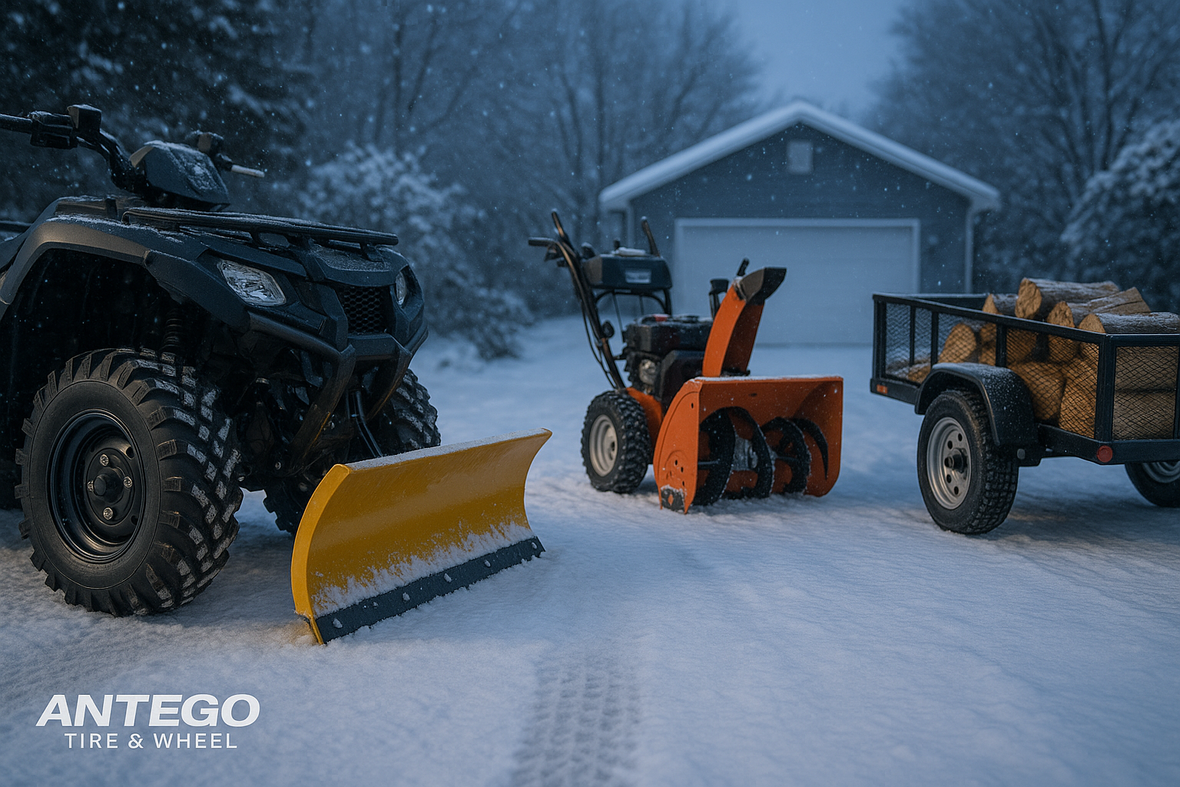
Winter Prep Checklist: Tires & Wheels for Snowblowers, ATVs, and Utility Trailers
Winter Prep Checklist: Tires & Wheels for Snowblowers, ATVs, and Utility Trailers
Cold snaps expose weak tires, worn treads, and low PSI. A quick pre-winter check prevents downtime, improves traction on ice/snow, and protects turf. Here’s a simple checklist to get every machine ready.
Step 1 — Inspect Tread & Sidewalls
-
Snowblowers: Look for rounded lugs and cracking; replace if lugs are <3–4 mm. Consider knobby/aggressive patterns for icy driveways.
-
ATVs/UTVs: If you plow or haul, prioritize a directional or deep-lug pattern. Radials ride smoother; bias-ply can offer stiff sidewalls for loads.
-
Trailers: Check for weather checking, cupping, and uneven wear—often a sign of underinflation or alignment issues.
Step 2 — Choose the Right Load Rating & Ply
-
Match load to job: Plowing and salting = higher load rating.
-
Trailer tires (ST): Verify Load Range (C/D/E) meets or exceeds your gross trailer weight.
-
Rule of thumb: Never “downsize” load rating for winter conditions.
Step 3 — Optimize Pressure for Cold Weather
-
Air contracts in the cold; PSI drops ~1 psi per 10°F.
-
Set PSI cold (before running).
-
Pro tip: Keep a quality inflator and gauge in the shop or truck for weekly checks. (Check our website for our selection of JACO inflators)
Step 4 — Select a Tread That Bites
-
Snowblowers: Chunky, open-lug patterns clear slush.
-
ATVs/UTVs: Look for multi-angle lugs for packed snow.
-
Zero-Turns on winter duty: If you tow or use attachments, consider a turf-friendly lug that won’t tear dormant grass yet grips on frost.
Step 5 — Consider Pre-Mounted Assemblies
-
Why assemblies win in winter: Faster swap, fresh beads, no wrestling cold rubber, matched rim/tire for airtight seal.
-
Tip: Keep a spare set labeled “winter” to minimize downtime mid-storm.
Step 6 — Check Bearings, Bushings & Valve Stems
-
Replace dry/cracked valve stems; they leak most in freezing temps.
-
Spin wheels and listen for grind (bearings). Tighten lugs to spec.
-
Add a dab of anti-seize on hubs if you swap sets seasonally.
Step 7 — Storage & Off-Season Protection
-
Trailer tires: If sitting, use stands or move monthly to avoid flat-spotting.
-
All equipment: Store clean, dry, out of UV to prevent sidewall cracking. Tire covers help.
Popular Winter-Ready Sizes We Stock (Examples)
-
Snowblower: 13x5.00-6, 15x5.00-6, 16x6.50-8
-
ATV/UTV: 25x8-12 / 25x10-12 sets, 26x9-12 / 26x11-12
-
Utility Trailer (ST): ST175/80R13, ST205/75R14, ST205/75R15
Quick Troubleshooting
-
Loses air overnight: Check bead seating and valve cores; clean bead and reseat if needed.
-
Spins on ice: Drop to manufacturer-approved PSI (never below spec), add weight where safe, and consider a more aggressive tread.
-
Trailer sway: Confirm tongue weight, tire PSI, and that you’re on ST tires, not passenger tires.
Final Take
A one-hour inspection now saves hours during the first storm. If you’re unsure on size, offset, or load range, our team can help you match a winter-ready assembly today.



